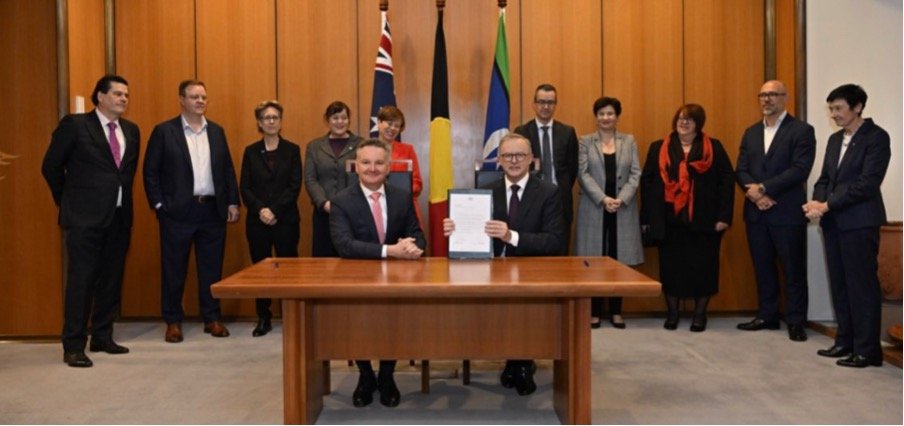Member/Partner News
Australia commits to 43pc reduction in emissions

The supply and cost of electricity have featured prominently on the agenda of Australia’s newly elected political party and in recent news bulletins
Most of the news is positive, the highlight being the government’s stated ambition to raise emission reductions targets to 43 per cent by 2030, well up on the previous government’s weak target of 26-28 per cent which was well out of step with the Paris Climate accord.
Australian Energy Minister Chris Bowen (seated on left in above image with Prime Minister Anthony Albanese) declared it’s time to put the decade of climate denial and climate wars behind us and transform Australia to a renewable economy.
“We will work hand in hand with anyone who wants a better future, powered by cheaper and cleaner renewable energy,” he said. “Australians will benefit from the lower power prices of renewable energy and Australian businesses benefit from having the certainty to invest.”
Investment certainty is overdue a decade which makes such words very welcome.
SEC’s John Grimes, who was among the influential few invited to witness the momentous signing of the 43 per cent target declared “This is a huge day for renewables and smart energy… this is leadership.”
His sentiments were amplified by SEC President Steve Blume who said “This sets the tone for a rapid transition to renewables and progressing matters with an action plan to exceed that target”.
But the path of smart energy never runs smoothly.
One week later the nation was facing shortfalls in energy supply brought on by a sudden wintery cold snap and ageing coal plants, some offline, unable to cope with demand, exacerbated by spiralling prices caused by the war in Ukraine.
On the positive side the intense media focus on energy shortages and price spikes was matched by consumer attention on the benefits of solar PV to future proof homes and businesses, triggering a near threefold interest in rooftop installation. A fifth of those enquiring about solar power also expressed interest in battery storage attachments which signals a positive shift to smarter energy systems.
The threat of electricity shortfalls coincided with the Energy Security Board’s (ESB’s) draft paper on energy Capacity Mechanisms which only perpetuated intensity media scrutiny of energy matters.
Prior to release of the ESB’s paper the Smart Energy Council presented a wish list placing renewable energy and climate action at the core. The list urges faster, cheaper decarbonisation, the sole backing of zero emissions new generation, ruling out ‘CoalKeeper’, and fast-tracking home, commercial, large-scale zero emissions energy storage and uptake of electric vehicles.
John Grimes said Australia can be a renewable energy superpower with cheap, reliable, zero emissions power but we need more support for renewable energy storage.
Critically, the SEC also recommends governments examine all options to get Australia to at least 82pc renewables by 2030 and proposes establishment of Renewable Energy Storage Target(s).
The framework outlines a rational path for a smart 21st century grid that should have been put in motion decades ago.
Yet some are still beholden to the dark ages. The greater renewables industry was alarmed by the ESB’s draft paper which recommends payments to coal and gas generators to provide certainly of energy supply. Namely to pay them to do what they are built to do – provide reliable energy supplies.
By any other name, a coal keeping, fossil fuel subsidising mechanism that is welcomed only by coal related entities.
The travesty was thrashed out by leading energy experts and analysts at the Smart Energy Summit on June 22. There was consensus the solution lies not in placing dilapidated, polluting coal plants on palliative care but by developing greater wind, solar and energy storage capacity.
Contrary to the needs - and Australia’s newly stated aspirations - to bolster action on climate by reining in emissions, the proposed capacity mechanism is likely to stall investment in new generation and delay the orderly exit of coal plants by their use-by-date.
But the paper is draft only. Perhaps state governments committed to fast-tracking renewable energy and carbon emissions reductions targets could thwart coal ‘capacity’ payments, should it come to crunch.
That is the stated intent of Victoria’s Energy Minister who told the Smart Energy Summit she opposes coal subsidies and that a capacity mechanism in Victoria would pay only for zero emission technologies, not fossil fuels.
Australia’s other most populous state, New South Wales, is investing significantly in renewable energy to lower bills and deliver “the most reliable and clean energy in the world” which likewise is out of step with coal capacity payments. Fossil fuels served their purpose back in the day but sent the PPM count skyrocketing and it’s time to make reparations by expanding all forms of renewables while setting and meeting storage targets. It’s nearly but not quite too late to decarbonise.
![Global Solar Council [logo]](/static/images/gsc-logo-horizontal.svg)